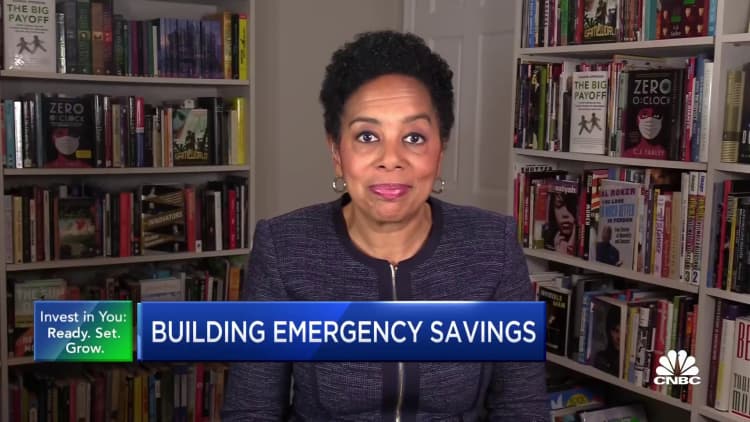Picture this: You come home after a long day. As you approach your front door, you reach for your keys — but don’t feel them in your pocket.
You quickly realize you’re locked out of your home. Luckily, on-call locksmiths are available to help.
However, an emergency visit like this can cost as much as $400, depending on your location and the time, lock type, service and trip fees, according to This Old House, a home improvement information and advice platform. (The average cost nationwide is $150, the platform found.)
More from Personal Finance:
61% of adults live paycheck to paycheck as inflation squeezes
What borrowers need to know as student loan interest resumes
Why it’s hard to find a cheap new car these days
Unfortunately, more than half — or 63% — of American workers are unable to cover a $500 emergency expense, found SecureSave, a provider of financial technology that helps employers offer emergency savings benefits. And only 48% of respondents to a May poll of 1,000 U.S. adults by Bankrate say they have enough emergency savings to cover at least three months’ worth of expenses.
Due to this lack of emergency savings, people are more likely to finance an unforeseen expense on credit cards or dip into retirement savings accounts.
In fact, the share of 401(k) plan participants who made a hardship withdrawal reached an all-time high in 2022, Vanguard found.

Furthermore, 32% of adults could not have covered an emergency $400 expense completely with cash in 2021, according to the Federal Reserve. Their most common approach, instead, was to put the emergency expense on a credit card and pay it over time.
“It’s certainly common now, and a lot of people sometimes feel like they don’t know where to start,” said financial advisor Winnie Sun, co-founder and managing director of Irvine, California-based Sun Group Wealth Partners and a member of the CNBC FA Council.
Here are other common emergency calls with their average costs:
1. Car trouble
A tow truck recovers the vehicle driven by golfer Tiger Woods in Rancho Palos Verdes, California, on Feb. 23, 2021, after a rollover accident.
Frederic J. Brown | AFP | Getty Images
Locksmiths can also help if you left your car keys inside your vehicle. However, service costs, again, depend on the distance a locksmith travels, time of day, and the type of lock and effort needed.
On average, unlocking the door can run from $70 up to $150 nationwide, while rekeying the car door can balloon to as much as $600, J.D. Power found.
Meanwhile, if your car breaks down or you get into an accident, you may need to call a tow truck.
The average cost of getting your car towed is $109, according to J.D. Power. Yet, several factors impact the price, such as your location and how far you need to go; you could pay up to $600 to go as far as 100 miles.
2. Medical emergencies
Marje Cannon | E+ | Getty Images
Serious health-related events — like a critical illness, infection or accident — may mean you need to either dial an emergency number or run to the nearest hospital ER or urgent-care facility.
The chances of first responders taking you to a medical center where physicians who are covered by your exact health insurance provider work are low to none.
On average, urgent-care visits cost up to $200, while hospital emergency room visits can cost as much $1,300, according to American Family Care.
3. Household repairs
JGI/Tom Grill | Tetra images | Getty Images
Last year, homeowners spent an average of $1,953 on home emergency spending, according to home services website Angi. Emergency spending had the largest increase in 2021 due to natural disasters in Texas, California and New York; 40% of respondents were impacted by extreme weather events, Angi found.
Some of the most common emergency household repairs including fixing bursting, freezing or leaking pipes; leaks from the roof; overflowing toilets; gas leaks; electrical hazards; termite or mice infestations; and mold growth, according to home management platform Thumbtack.
Consider alternate financial safety nets
“Everybody should try to have an emergency fund set aside,” said certified financial planner Carolyn McClanahan, founder of Life Planning Partners in Jacksonville, Florida and also a CNBC FA Council member. “If they don’t have an emergency fund set aside, it’s important to know where to get cash if you need it.”
To better protect yourself from incurring such high emergency costs, consider these alternate financial safety nets:
1. Use credit cards wisely: You really need to see credit cards as a last resort, said Sun. If you do use your credit card, make sure you prioritize paying off the balance in full by the end of the month, she added. Otherwise, high-level interest rates can inflate the amount owed quickly. “Use your credit card as a 30-day bridge, but commit to paying that off,” she said.
2. Set up a home equity line of credit: A home equity line of credit, or HELOC, is a loan secured by your house’s equity. It can work as an emergency line of credit, as well, said Sun. Applying for a HELOC is similar to taking out a mortgage for a house, added McClanahan.
“You can open a HELOC and not use it until a disaster happens,” she said.
HELOCs interest rates are generally lower than credit card interest rates. McClanahan noted.
“Depending on the bank, your interest rate can be from 8% to 10%, versus 20% to 30% on a credit card,” she said.
However, they tend to be variable interest rates, so you don’t want to use it if you don’t have to, McClanahan explained.
This makes it harder for to “budget from month to month,” said Seth Bellas, a branch manager with Churchill Mortgage, earlier this year.
However, don’t wait until you have an emergency to apply for a HELOC, said McClanahan; the key is to have it open before you need it and pay it off as fast as possible, she added. Give yourself 2-3 months to set it up, added Sun.
3. Look into roadside assistance coverage: For a flat monthly or annual fee, roadside assistance plans can help if you’re locked out of your car, need it towed or have to have it pulled out of mud, sand or snow.
But first check with your auto insurance provider, advised McClanahan. And, review your policy to make sure what’s included in your coverage, according to Sun.
Roadside assistance plans from car insurance companies are usually the cheapest option, WalletHub has found. However, it’s usually added to an existing policy or only available when a policy has collision and comprehensive coverage.
4. Avoid surprises by planning ahead: Whatever the emergency, it pays to have planned ahead.
“If you have an old car and it has lots of miles, you always have to be prepared when the car breaks down,” McClanahan said.
Put money away in a car fund the same way you set money aside in an emergency fund.
The key is to remember that you’re investing in yourself when you put money away, whether for short-term emergencies or long-term goals, she added.
As for that locked front door, a good way to avoid a big locksmith bill in the first place is put a spare set of your keys in a lockbox outside your home or in the hands of a trusted friend, said McClanahan.

